Fashion of the 1900 Party Champagne Color Ne
| 1900 Paris | |
|---|---|
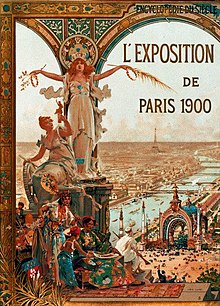 Poster | |
| Overview | |
| BIE-course | Universal exposition |
| Category | International Recognized Exhibition |
| Name | L'Exposition de Paris 1900 |
| Building(due south) | Grand Palais, Petit Palais, Paris Métro |
| Area | 216 hectares (530 acres) |
| Visitors | 48,130,300 |
| Participant(southward) | |
| Business | 76,112 |
| Location | |
| Country | France |
| City | Paris |
| Venue | Esplanade des Invalides, Champ de Mars, Trocadéro, banks of the Seine and Bois de Vincennes |
| Timeline | |
| Opening | 14 April 1900 (1900-04-14) |
| Closure | 12 November 1900 (1900-xi-12) |
| Universal expositions | |
| Previous | Brussels International (1897) in Brussels |
| Adjacent | Louisiana Purchase Exposition in St. Louis |
The Exposition Universelle of 1900, improve known in English as the 1900 Paris Exposition, was a world's off-white held in Paris, France, from 14 Apr to 12 November 1900, to celebrate the achievements of the by century and to accelerate development into the next. It was held at the esplanade of Les Invalides, the Champ de Mars, the Trocadéro and at the banks of the Seine between them, with an additional section in the Bois de Vincennes, and it was visited past more than 50 meg people. Many international congresses and other events were held within the framework of the Exposition, including the 1900 Summer Olympics.
Many technological innovations were displayed at the Off-white, including the Grande Roue de Paris ferris cycle, the Rue de l'Avenir moving sidewalk, the first ever regular passenger trolleybus line, escalators, diesel fuel engines, electrical cars, dry jail cell batteries, electrical fire engines, talking films, the telegraphone (the first magnetic audio recorder), the galalith and the matryoshka dolls. Information technology besides brought international attention to the Art Nouveau way. Additionally, it showcased France as a major colonial power through numerous pavilions built on the hill of the Trocadéro Palace.
Major structures built for the Exposition include the Grand Palais, the Petit Palais, the Pont Alexandre 3, the Gare d'Orsay railroad station and the entrances of Paris Métro stations by Hector Guimard; all of them remaining today, including two original entrances by Guimard.
Organization [edit]
The first international exposition was held in London in 1851. The French Emperor Napoleon Iii attended and was deeply impressed. He commissioned the offset Paris Universal Exposition of 1855. Its purpose was to promote French commerce, technology and civilisation. It was followed past another in 1867, and, later the Emperor's downfall in 1870, another in 1878, celebrating national unity after the defeat of the Paris District, and then in 1889, jubilant the centennial of the French Revolution.[1] [2]
Planning for the 1900 Exposition began in 1892, under President Carnot, with Alfred Picard every bit Commissioner-Full general. 3 French Presidents and x Ministers of Commerce held role earlier it was completed. President Carnot died shortly before information technology was completed. Though many of the buildings were not finished, the Exposition was opened on 14 April 1900 past President Émile Loubet.[3] [2]
-

Opening ceremony on 14 April 1900
Participating Nations [edit]
Countries from around the world were invited past France to showcase their achievements and cultures. Of the fifty-six countries invited to participate with official representation, forty accustomed, plus an additional number of colonies and protectorates of France, the Netherlands, Great Great britain, and Portugal.[four]
| Participating Nations[5] | |||
|---|---|---|---|
|
Republic of austria, Bosnia-Herzegovina and Hungary participated every bit independent nations, although belonging to Republic of austria-Hungary at that time. Finland, although having a national pavilion located at the Rue des Nations, officially participated equally part of Russia. Egypt, as well with an own pavilion, participated every bit part of Turkey. The few exhibitors from countries without an official presence at the Fair participated under a joint "International Section".[five]
Among the colonies and protectorates present in the Fair were French Algeria, Kingdom of cambodia, Congo, Dahomey, Guadeloupe, Guiana, Republic of guinea, India, Indochina, Ivory Coast, Laos, Madagascar, Martinique, Mayotte, New Caledonia, Oceania, Réunion, Senegal, Somaliland, Sudan, Tonkin, Tunisia, W Africa, Saint Pierre and Miquelon, the Dutch Due east Indies, British Canada, Ceylon, Bharat and Western Commonwealth of australia and the Portuguese colonies.[5]
Exposition Site [edit]
The site of the Exposition covered 112 hectares (280 acres) forth the left and right banks of the Seine from the esplanade of Les Invalides to the Eiffel Tower (built for the 1889 Exposition) at the Gnaw de Mars. Information technology besides included the Grand Palais and Petit Palais on the right bank. An additional section of 104 hectares (260 acres) for agronomical exhibits and other structures was built in the Bois de Vincennes. The total area of the Exposition, 216 hectares (530 acres), was ten times larger than the 1855 Exposition.[4]
The Exposition buildings were meant to be temporary; they were congenital on iron frames covered with plaster and staff, a kind of inexpensive bogus stone. Many of the buildings were unfinished when the Exposition opened, and well-nigh were demolished immediately after it closed.
-

Aerial view of the Exposition Universelle
-

Map of the Exposition
The Porte Monumentale [edit]
The Porte Monumentale de Paris, located on the Identify de la Concorde, was the main archway of the Exposition. The architect was René Binet. It was composed of towering polychrome ceramic decoration in Byzantine motifs, crowned by a statue 6.5 metres (21 ft) high called La Parisienne. Unlike classical statues, she was dressed in modernistic Paris manner. Beneath the statue was a sculptural prow of a boat, the symbol of Paris, and friezes depicting the workers who congenital the Exposition. The central curvation was flanked by two slender, candle-similar towers, resembling minarets. The gateway was brightly illuminated at night by 3,200 calorie-free bulbs and an additional twoscore arc lamps. Forty thousand visitors an 60 minutes could laissez passer beneath the arch to approach the 20-six ticket booths.[6] [7]
The Gateway, like the Exposition buildings, was intended to be temporary, and was demolished as soon as the Exposition was finished. The ceramic frieze depicting the workers of the Exposition was preserved by the caput of the ceramics firm that fabricated it, Émile Müller, and moved to what is now Parc Müller in the town of Breuillet, Essonne.
-

Detail of the Porte Monumentale entrance
The Pont Alexandre III [edit]
The Pont Alexandre Iii was an essential link of the Exposition, connecting the pavilions and palaces on the left and right banks of the Seine. It was named after Czar Alexander III of Russian federation, who had died in 1894, and celebrated the contempo alliance between France and Russia. The foundation stone was laid past his son, Czar Nicholas II in 1896, and the span was finished in 1900. It was the work of engineers Jean Resal and Amédée D'Alby and builder Gaston Cousin. The widest and longest of the Paris bridges at the fourth dimension, it was synthetic on a single arch of steel 108 metres (354 ft) long. Though it was named afterwards the Russian Czar, the themes of the decoration were almost entirely French. At the ends, the bridge was supported by four massive stone pylons 13 metres (43 ft) loftier, busy with statues of the Renomées (The Renowned), female figures with trumpets, and aureate statues of the horse Pegasus. At the base of the pedestals are emblematic statues representing the France of Charlemagne, the France of the Renaissance, the France of Louis 14 and France in 1900.[8] The Russian element was in the eye, with bronze of the Nymphs of the Neva River property a gold seal of the Russian Empire. At the same time that the Pont Alexander III was congenital, a like span, the Trinity Bridge was built in Saint-Petersburg, and was dedicated to French-Russian friendship by French President Félix Faure.
-

View of the Pont Alexandre Iii toward Les Invalides
-

The Pont Alexandre III with the Grand Palais (left) and the Petit Palais (right) in the background
-

View of the Seine from the Pont Alexandre III
Thematic pavilions [edit]
To firm the industrial, commercial, scientific, technological and cultural exhibitions, the French arrangement built huge thematic pavilions on the esplanade of Les Invalides and the Champ de Mars and reused the Galerie des machines from the 1889 Exposition. On the other bank of the Seine, they built the M Palais and the Petit Palais for the fine arts exhibitions.[9]
The 83,047 French and foreign exhibitors at the Fair were divided into 18 groups based on their subject affair, which in turn were divided into 121 classes, and based on the class to which they belonged, they were alocated in the corresponding official thematic pavilion. Each thematic pavilion was divided into national sections, which were the responsibility of the respective country and where its exhibitors were located. Some country with a potent presence in a specific sector, at its own request, was fifty-fifty granted a plot adjoining to the main building to built a small pavilion to house its exhibitors.[9]
The Palaces of Optics, Illusions and Aquarium [edit]
Twenty-1 of the thirty-iii official pavilions were devoted to engineering science and the sciences. Among the well-nigh popular was the Palace of Optics, whose main attractions included the Great Paris Exposition Telescope, which enlarged the prototype of the moon ten thousand times. The paradigm was projected on a screen 144 square metres (1,550 sq ft) in size, in a hall which seated two thousand visitors. This telescope was the largest refracting telescope at that time. The optical tube assembly was lx metres (200 ft) long and 1.5 metres (4 ft 11 in) in diameter, and was fixed in place due to its mass. Light from the sky was sent into the tube by a movable 2 metres (6 ft 7 in) mirror.
Another very popular feature of the Palace of Optics was the giant kaleidoscope, which attracted iii 1000000 visitors. Other features of the optics pavilion included demonstrations of X-rays and dancers performing in phosphorescent costumes.
The Palais des Illusions (Palace of Illusions), bordering the Palace of Optics, was an extremely pop exhibition. It was a large hall which used mirrors and electrical lighting to create a prove of colorful and bizarre optical illusions. It was preserved after the Exposition in the Musée Grévin[10]
Another scientific allure was the aquarium, the largest in the globe at the time, viewed from an undercover gallery 722 metres (2,369 ft) long. The water tanks were each 38 metres (125 ft) long, 18 metres (59 ft) broad and six.v metres (21 ft) deep, and contained a wide pick of exotic marine life.
-

Entrance of the Palace of Optics
-

-

The Palais des Illusions created a show of optical illusions with mirrors and lighting effects.
The Palace of Electricity and the Water Castle [edit]
The Palace of Electricity and the bordering Water Castle (Chateau d'Eau), designed by architects Eugène Hénard and Edmond Paulin,[seven] were amidst the most popular sights. The Palace of Electricity was built partly incorporating architectural elements of the sometime Palace of the Champ de Mars from the 1889 Exposition. The Palace was enormous, 420 metres (one,380 ft) long and sixty metres (200 ft) wide, and its form suggested a giant peacock spreading its tail. The central tower was crowned by an enormous illuminated star and a chariot carrying a statue of the Spirit of Electricity 6.5 metres (21 ft) loftier, holding aloft a torch powered by 50,000 volts of electricity, provided by the steam engines and generators inside the Palace. Electric lighting was used extensively to go on the Fair open well into the dark. Producing the low-cal for the Exposition consumed 200,000 kilograms (440,000 lb) of oil an 60 minutes.[eleven] The facade of the Palace and the Water Castle, across from it, were lit by an additional 7,200 incandescent lamps and seventeen arc lamps.[12] [7] Visitors could go within to see the steam-powered generators which provided electricity for the buildings of the Exposition.[7] [2]
The Water castle, facing the Palace of Electricity, had an equally imposing advent. It had two large domes, between which was a gigantic fountain, circulating 100,000 litres (22,000 imp gal; 26,000 US gal) of h2o a infinitesimal. Thank you to the ability from Palace of Electricity, the fountain was illuminated at dark by continually changing colored lights.[xi]
-
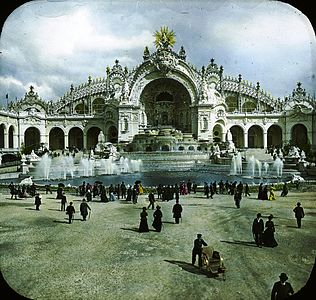
The Palace of Electricity (behind) and the Water Castle (in front)
The Grand Palais and Petit Palais [edit]
The M Palais, officially the Thousand Palais des beaux-arts et des arts decoratifs, was congenital on the correct banking concern upon the site of the Palace of Industry of the 1855 Exposition. Information technology was the piece of work of two architects, Henri Deglane for the chief body of the building, and Albert Thomas for the westward wing, or Palais d'Antin. The fe frame of the Grand Palais was quite modern for its fourth dimension; it appeared light, only in fact, it used ix,000 tonnes (viii,900 long tons; 9,900 curt tons) of metal, compared with seven thousand for the construction of the Eiffel Tower.[13] The facade was in the ornate Beaux-Arts style or Neo-Bizarre style. The more than modern interior iron framework, huge skylights and stairways offered decorative elements in the new Art Nouveau style,[7] especially in the railings of the staircase, which were intricately woven in fluid, organic forms.[2] During the Fair, the interior served as the setting for the exhibitions of paintings and sculptures.[7] The main body of the K Palais housed the Exposition décennale des beaux-arts de 1889 à 1900 with the paintings of French artists in the northward wing, the paintings of artists from other countries in the due south wing and the sculptures in the central hall, with some outdoor sculptures nearby.[14] The Palais d'Antin, or due west wing, housed the Exposition centennale de l'art français de 1800 à 1889.[fifteen]
The Petit Palais, that is facing the Yard Palais, was designed by Charles Girault.[seven] Much like the Grand Palais, the facade is Beaux-Arts and Neo-Baroque, reminiscent of the Chiliad Trianon and the stable at Chantilly.[7] The interior offers examples of Art Nouveau, peculiarly in the railings of the curving stairways, the tiles of the floors, the stained glass, and the murals on the ceiling of the arcade around the garden.[7] The entrance murals were painted past Paul-Albert Besnard and Paul Albert Laurens.[seven] During the Off-white, the Petit Palais housed the Exposition rétrospective de 50'art français des origines à 1800.[16]
The Palaces of Industry, Decoration and Agronomics [edit]
The industrial and commercial exhibits were located within several big palaces on the esplenade betwixt les Invalides and the Alexander III Bridge. One of the largest and about ornate was the Palais des Articles Nationale, whose facade included a colorful ceramic gateway, designed by sculptor Jules Coutan and builder Charles Risler and made past the Sèvres Porcelain manufactory. After the Exposition it was moved to the wall of Square Felix-Déésroulles, next to the Abbey of Saint-Germain-des-Prés, where it can be seen today.[17]
The Palace of Furniture and Ornamentation was peculiarly lavish and presented many displays of the new Art Nouveau style.
The Palace of Agriculture and Food was inside the sometime Galerie des machines, an enormous iron-framed building from the 1889 Exposition. Its near popular feature was the Champagne Palace, offering displays and samples of French Champagne.
-

The Palace of National Manufacturers (left), with the Italian pavilion in distance
-

United States department at the Palace of Piece of furniture and Decoration
-
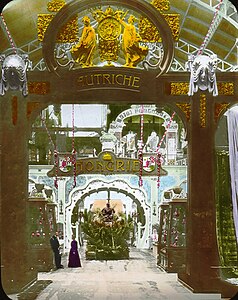
Austrian department at the Palace of Furniture and Decoration
-

Pavilion of Agriculture and Food, inside the sometime Palace of Machines of the 1889 Exposition.
-

The Champagne Palace at the Palace of Agriculture and Nutrient
National pavilions [edit]
50-six countries were invited to the Exposition, and xl accustomed. The Rue des Nations was created along the banks of the Seine betwixt the esplanade of Les Invalides and the Champ de Mars for the national pavilions of the larger countries. Each state paid for its own pavilion. The pavilions were all temporary, made of plaster and staff on a metal frame and were designed in an architectural style that represented a menstruum in the country's history, often imitating famous national monuments.[2]
At the Rue des Nations, on the left bank of the Seine, on the Quai d'Orsay, overlooking the river, from the Pont des Invalides towards the Pont de l'Alma, were located the national pavilions of Italy, Turkey, the United States, Republic of austria, Bosnia and herzegovina, Republic of hungary, Great Britain, Belgium, Kingdom of norway, Frg, Kingdom of spain, Monaco, Sweden, Greece, Serbia and Mexico. Behind them, in 2d line, were located the pavilions of Kingdom of denmark, Portugal, Peru, Persia, Finland, Luxembourg, Republic of bulgaria and Romania. The other nations were located elsewhere in the Exposition site.[two]
In addition to their ain national pavilion, the countries managed other spaces at the Off-white. The industrial, commercial, scientific and cultural exhibitors of each land were distributed among the national sections of the dissimilar official thematic pavilions.[2]
The Rue des Nations [edit]
The pavilion of Turkey was covering four,000 foursquare metres (43,000 sq ft). It was designed by a French architect, Adrien-René Dubuisson, and was a mixture of copies of Islamic compages from mosques in Istanbul and elsewhere in the Ottoman Empire.[xviii]
The United States pavilion was minor, a variation on the U.s. Capitol Building designed past Charles Allerton Coolidge and Georges Morin-Goustiaux. The main U.S. presence was in the commercial and industrial palaces. One unusual aspect of the U.S. presence was The Exhibit of American Negroes at the Palace of Social Economy, a articulation project of Daniel Murray, the Banana Librarian of Congress, Thomas J. Calloway, a lawyer and the main organizer of the exhibit, and W. E. B. Du Bois. The goal of the exhibition was to demonstrate progress and commemorate the lives of African Americans at the turn of the century.[19] The showroom included a statuette of Frederick Douglass, four bound volumes of near 400 official patents by African Americans, photographs from several educational institutions (Fisk University, Howard Academy, Roger Williams Academy, Tuskegee Institute, Claflin University, Berea Higher, Due north Carolina A&T), and, most memorably, some v hundred photographs of African-American men and women, homes, churches, businesses and landscapes including photographs from Thomas E. Askew.[xx]
The pavilions of the Austro-Hungarian domains in the Balkans, Republic of bosnia and herzegovina, offered displays on their lifestyles, consisting of sociology traditions, highlighting peasanthood and the embroidery goods produced in the country.[vii] Designed by Karl Panek, information technology featured murals on the history of Slavic peoples by Alphonse Mucha.
The pavilion of Hungary was designed by Zoltán Bálint and Lajos Jámbor. Its cupola displayed agronomical produce and hunting equipment.[7]
The British Majestic pavilion consisted of a mock-Jacobean mansion decorated with pictures and furniture, designed by Sir Edwin Lutyens. It was largely used for receptions for important visitors to the Exposition.[2]
The German pavilion was the tallest, at 76 metres (249 ft), designed by Johannes Radke and built of wood and stained glass. However, most of the German presence at the Exposition was in the commercial pavilions, where they had important displays of German technology and machinery, as well equally models of German steamships and a full-scale model of a German lighthouse.[2]
The Royal Pavilion of Espana was designed in Neo-Plateresque mode past José Urioste Velada. It housed the Retrospective Exhibition of Spanish Art formed by the collection of tapestries, in which 30-seven pieces fabricated betwixt the 15th and 18th centuries from the Royal Collections were exhibited. The pavilion basement housed a Spanish-themed café-eating place, named La Feria, that was the first eating house in History with a completely electric kitchen.[21]
Sweden's xanthous and red structure covered in pine shingles drew attention with its bright colours. It was designed past Ferdinand Boberg.[ii]
The pavilion of Finland, designed by Gesellius, Lindgren, Saarinen, had clean-cut, modern architecture.[2]
-

Rue des Nations. From left to right: Pavilions of Kingdom of belgium, Norway, Germany, Spain, Monaco, Sweden, Hellenic republic and Serbia.
-

Pavilion of Italian republic by Carlo Ceppi, Costantino Gilodi and Giacomo Salvadori
-

Pavilion of Turkey by Adrien-René Dubuisson
-

Pavilion of the United States by Coolidge and Morin-Goustiaux
-

Pavilions of Republic of bosnia and herzegovina by Karl Panek (left) and Hungary by Zoltán Bálint and Lajos Jámbor (right)
-

Pavilion of Belgium past Ernest Acker and Gustave Maukels
-

Pavilion of Monaco by Jean Marquet and François Medecin
-
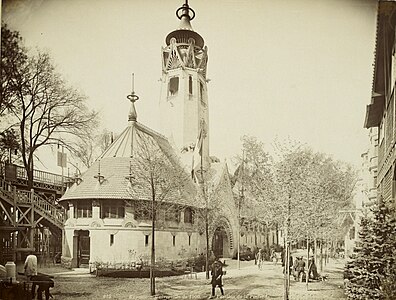
Nations located elsewhere [edit]
Russia had an imposing presence on the Trocadéro hill. The Russian pavilion, designed by Robert Meltzer, was inspired by the towers of the Kremlin and had exhibits and architecture presenting artistic treasures from Samarkand, Bukhara and other Russian dependencies in Key Asia.[22]
The Chinese pavilion, designed by Louis Masson-Détourbet, was in the form of a Buddhist temple with staff in Chinese traditional clothes. This pavilion suffered some disruption in August 1900, when anti-Western rebels seized the International delegations in Beijing in the Boxer Rebellion and held them for several weeks until an expeditionary strength from the Eight-Nation Alliance arrived and recaptured the metropolis. During the disruption at the Fair, a Chinese procession was attacked past angered Parisians.[23]
The Korean pavilion, designed by Eugène Ferret, was mostly stocked by French Oriental collectors, including Victor Collin de Plancy, with a supplement of Korean goods from Korea.[24] One object of note on display was the Jikji, the oldest extant volume printed with movable metal type.[25]
Kingdom of morocco had its pavilion near the Eiffel Tower and was designed by Henri-Jules Saladin.[22]
-

Pavilion of Russia by Robert Meltzer
-

Pavilion of China past Louis Masson-Détourbet
-

Pavilion of Kingdom of morocco by Henri-Jules Saladin
Colonial pavilions [edit]
An area of several dozen hectares on the hill of the Trocadéro Palace was fix aside for the pavilions of the colonies and protectorates of France, holland, U.k., and Portugal.
The largest space was for the French colonies in Africa, the Caribbean, the Pacific and Southeast Asia. These pavilions featured traditional architecture of the countries and displays of local products mixed with mod electric lighting, move pictures, dioramas, and guides, soldiers, and musicians in local costumes. The French Caribbean islands promoted their rum and other products, while the French colony of New Caledonia highlighted its exotic varieties of forest and its rich mineral deposits.[22]
The North African French colonies were especially present; The Tunisian pavilion was a miniature recreation of the Sidi Mahrez Mosque of Tunis. Algeria, Sudan, Dahomey, Guinea and the other French African colonies presented pavilions based on their traditional religious architecture and marketplaces, with guides in costume.[22]
The French colonies of Indochina, Tonkin and Cambodia too had an impressive presence, with recreations of pagodas and palaces, musicians and dancers, and a recreation of a riverside village from Laos.[22]
The Netherlands displayed the exotic civilization of its crown colony, the Dutch East Indies. The pavilion displayed a true-blue reconstruction of eighth-century Sari temple and also Indonesian vernacular architecture of Rumah Gadang from Minangkabau, West Sumatra.
Attractions [edit]
Besides its official scientific, industrial and artistic palaces, the Exposition offered an boggling variety of attractions, amusements and diversions.
Eiffel Tower [edit]
The Eiffel Tower, that was built equally the chief entrance of the 1889 Exposition, was the master and central attraction of the 1900 Exposition. For this Exposition, it was repainted in shaded tones from xanthous-orange at the base to light yellow at the top, and was fitted with seven,000 electric lamps. At the same time, the lifts in the e and w legs were replaced by lifts running as far as the second level and the lift in the north pillar was removed and replaced past a staircase to the first level. The layout of both first and second levels was modified, with the space available for visitors on the second level.[26]
-

Aerial view of the Exposition including the Eiffel Tower.
-

View of the Champ de Mars nether the Eiffel Tower
The Grande Roue de Paris [edit]
The Grande Roue de Paris was a very pop allure. It was a gigantic ferris wheel 110 metres (360 ft) high, which took its name from a similar bicycle created past George Washington Gale Ferris Jr. at the 1893 Earth's Columbian Exposition in Chicago. It could comport one,600 passengers in its forty cars in a unmarried voyage. The cost of a ride was one franc for a 2d course automobile, and two francs for a more spacious start-class motorcar. Despite the high toll, passengers often had to wait an 60 minutes for a place.[27]
-
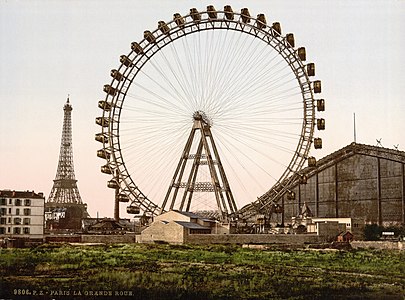
The Grande Roue at the Paris Exposition could conduct 1600 passengers at once
The moving sidewalk, electric train and electrobus [edit]
The Rue de fifty'Avenir (transl. Street of the future) moving sidewalk was a very popular and useful attraction, given the large size of the Exposition. It ran along the border of the Exposition, from the esplanade of Les Invalides to the Champ de Mars, passing through ix stations forth the way, where passengers could board. The fare was an average of fifty centimes. The sidewalk was accessed from a platform seven metres (23 ft) above the ground level. The passengers stepped from the platform onto the moving sidewalk traveling at 4.two kilometres per hr (ii.6 mph), and so onto a more rapid sidewalk moving at 8.5 kilometres per hour (five.three mph). The sidewalks had posts with handles which passengers could hold onto, or they could walk. It was designed past architect Joseph Lyman Silsbee and engineer Max Eastward. Schmidt.[28]
A Decauville electric train followed the aforementioned route, running at an average speed of 17 kilometres per hour (xi mph) in the contrary direction of the moving sidewalk. The rail track was sometimes at 7 metres (23 ft) loftier like the movable sidewalks, sometimes at basis level and sometimes surreptitious.[29]
An experimental rider electrobus line, designed past Louis Lombard-Gérin, ran in the Bois de Vincennes from 2 August to 12 November 1900. It was a ii.five kilometres (ane.half dozen mi) long circular route connecting the recently opened Porte de Vincennes metro station with Lac Daumesnil. It was the first trolleybus in regular passenger service in History.[xxx]
-
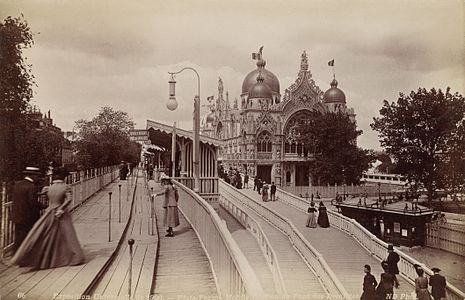
Quai d'Orsay-Pont des Invalides station of the moving sidewalk near the Pavilion of Italy
-
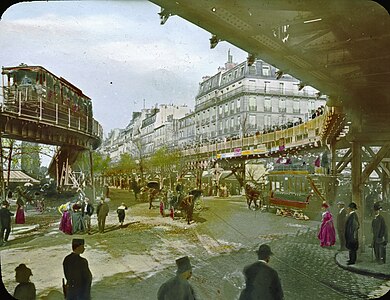
Viaducts of the electric train (left) and the moving sidewalk (right)
-
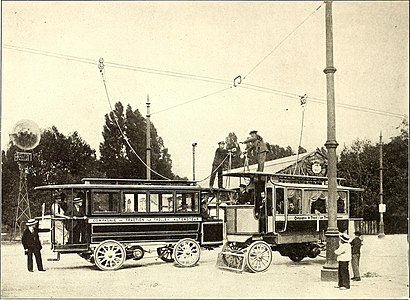
The outset ever trolleybuses in regular passenger service (Bois de Vincennes)
The Globe Céleste [edit]
The Globe Céleste was an immense globe-shaped planetarium which offered a presentation on the night sky. The globe, designed past Napoléon de Tédesco, was 45 metres (148 ft) in diameter, and the bluish and aureate exterior was painted with the constellations and the signs of the zodiac. Information technology was placed atop a masonry support 18 metres (59 ft) high, supported by four columns. A flower garden on the support surrounded the globe. Spectators seated in armchairs inside watched a presentation on the stars and planets projected overhead.
The sphere was the scene of a fatal accident on 29 April 1900 when one of admission ramps, hastily made of a newly introduced material, reinforced concrete, collapsed onto the street below, killing nine persons. Post-obit the blow the French government established the kickoff regulations for the use of reinforced physical.
-

The Globe Céleste was featured in an advertizement for Suchard Chocolate
Motility Pictures [edit]
The Lumière brothers, who had made the showtime public projections of a move moving-picture show in 1895, presented their films on a colossal screen, 21 metres (69 ft) by 16 metres (52 ft), in the Gallery of Machines. Some other innovation in move pictures was presented at the Exposition at the Phono-Cinema Theater; a primitive talking motility motion picture, where the epitome on the screen was synchronized to the audio from phonographs.[31]
An even more aggressive experiment in movement pictures was the Cinéorama of Raoul Grimoin Sanson, which false a voyage in a balloon. The moving picture, projected on a circular screen 93 metres (305 ft) in circumference past 10 synchronized projectors, depicted a landscape passing below. The spectators sat in the center above the projectors, in what resembled the handbasket suspended beneath a large balloon.[31]
Some other pop attraction was the Mareorama, which simulated a voyage past ship from Villefranche to Constantinople. The viewers stood on the railing of a ship simulator, watching painted images pass by of the cities and seascapes en road. The illusion was aided by machinery that rocked the send, and fans which blew gusts of current of air.[32]
-
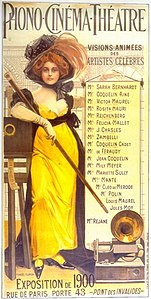
Poster for the Phono-Movie theater Theater
-

The Cinéorama, a false voyage in a balloon with move pictures projected on a circular screen.
-

The Mareorama simulated a sea voyage, complete with rocking send and unrolling painted scenery.
World live recreations [edit]
L'Andalousie au temps des Maures (transl. Andalusia In The Time Of The Moors) was a 5,000 m2 (54,000 sq ft) Spanish-themed open up air attraction with folkloric alive performances at Quai Debilly, at the western end of Trocadéro, on the right bank of the Seine, featuring full-scale moorish architecture reproductions from the Alhambra, Córdoba, Toledo, the Alcázar of Seville and a 80 m (260 ft) tall reproduction of the Giralda. It was a French-produced attraction that had no relation with the official representation of Spain at the Fair.[33]
Le Vieux Paris (transl. One-time Paris) was a recreation of the streets of old Paris, from the Centre Ages to the 18th century, with recreations of historic buildings and streets filled with performers and musicians in costumes. Information technology was congenital post-obit an idea by Albert Robida.[34]
The Swiss Hamlet, at the edge of the Exposition virtually Avenue de Sufren and Motte-Piquet, was a recreation of a Swiss mountainside hamlet, complete with a 35 metres (115 ft) cascade, a lake and drove of thirty-five chalets.[34]
The Panorama du Bout du Monde was an animated panorama journey from Europe to Nippon in a building by Alexandre Marcel in the architectural styles of India, Prc, Kingdom of cambodia, Nippon and Renaissance Europe. It consisted in panoramic paintings by Louis Dumoulin in front of which groups of native people, dressed appropriately, move, play, dance, stroll or piece of work. The visitor traveled through representations of Fuenterrabía (Spain), the Pnyx hill in Athens (Hellenic republic), the cemetery of Stamboul and the Golden Horn of Constantinople (Turkey), Syria, the Suez Culvert (Arab republic of egypt), Ceylon, the Angkor Wat temple (Kingdom of cambodia), Shanghai (Cathay) and Nikkō (Nippon). The visit continued past showing dioramas of Rome, Moscow, New York and Amsterdam and ended with a mobile panorama of a gunkhole trip forth the declension of Provence, from Marseille to La Ciotat. It was funded and sponsored by the Compagnie des messageries maritimes.[35]
Other recreations with costumed vendors and musicians elsewhere the Exposition included recreations of the bazaars, souks and street markets of Algiers, Tunis and Laos, a Venetian canal with gondolas, a Russian village and a Japanese tea house.[34]
-

Le Vieux Paris exterior
-

Le Vieux Paris
-
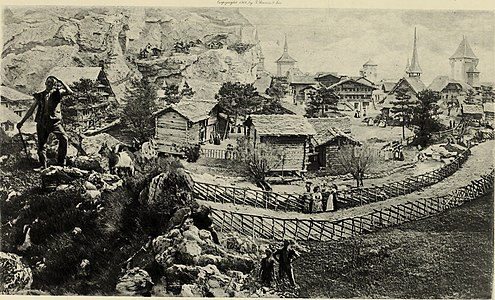
The Swiss Village
-

Panorama du Tour du Monde
Theatres and Music Halls [edit]
The Exposition had several large theatres and music halls, the largest of which was the Palais des Fêtes, which had xv thousand seats, and offered programs of music, ballet, historical recreations and various spectacles. A separate thoroughfare of the Exposition, the Rue de Paris, was lined with amusements, including music venues, a comedy theater, marionettes, American jazz, a Chiliad Guignol theater, and the celebrated "Backwards House", which had its furniture on the ceiling, its chandeliers on the floor, and windows which gave contrary images. Other diversions elsewhere in and around the Exposition included an orchestra from Madagascar, a One-act Theater, and the Columbia Theater at Port Maillot, with acts ranging from panoramas of life in the Orient to a water ballet. These diversions were popular but expensive; entry to the One-act Theater cost up to five francs.[36]
The near historic extra during the Exposition was Sarah Bernhardt, who had her own theater, The Théâtre Sarah Bernhardt (at present the Théâtre de la Ville), and premiered one of her most famous roles during the Exposition. This was L'Aiglon, a new play by Edmond Rostand in which she played the Duc de Reichstadt, the son of Napoleon Bonaparte, imprisoned by his unloving mother and family until his melancholy death in the Schönbrunn Palace in Vienna. The play ended with a memorable death scene; according to one critic, she died "as dying angels would die if they were allowed to."[37] The play ran for near a twelvemonth, with standing-room places selling for equally much every bit 600 gold francs.[38]
Another popular diversion during the Exposition was the theater of the American dancer, Loie Fuller, who performed a famous Serpentine trip the light fantastic in which she waved large silk scarves which seemed to envelop her into a deject. Her functioning was widely reproduced in photographs, paintings and drawings by Fine art Nouveau artists and sculptors, and were captured in very early motion pictures.[2] She was filmed on x 70mm projectors that created a 330-degree flick, patented by Cinéorama.[2]
-

The dancer Loie Fuller had her own theater in Paris during the 1900 Exposition
-
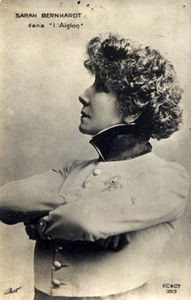
Sarah Bernhardt every bit L'Aiglon, the son of Napoleon Bonaparte, played to full houses in her theater during the Exposition.
Events [edit]
Many international congresses and other events were held in Paris in 1900 within the framework of the Exposition. A large area within the Bois de Vincennes was set bated for sporting events, which included, amongst others, many of the events of the 1900 Summer Olympics. A chess tournament was also held.
1900 Summer Olympics Games [edit]
The 1900 Summer Olympics were the second modern Olympics games held, and the first ones held outside Greece. Betwixt fourteen May and 28 October 1900, an enormous number of sporting activities were held along the Exposition. The sporting events rarely used the term of "Olympic". Indeed, the term "Olympic Games" was replaced past "Concours internationaux d'exercices physiques et de sport" (transl. "International physical exercises and sports contest") in the official written report of the Exposition. The press reported competitions variously as "International Championships", "International Games", "Paris Championships", "World Championships" and "Grand Prix of the Paris Exposition". The International Olympic Committee had no existent control over the organization, no official interpretation has ever been made and various sources list differing events, further adding to the confusion that was Paris 1900.[39]
997 competitors took part in nineteen different sports, including women competing for the outset fourth dimension.[xl] A number of events were held for the first and but time in Olympic history, including automobile and motorcycle racing, ballooning, cricket, croquet, a 200 metres (660 ft) swimming obstacle race and underwater swimming.[41] French republic provided 72% of all athletes (720 of the 997) and won the most gold, argent and bronze medal placings. The United States athletes won the second largest number, with just lxx-five of the 997 athletes.[42] The pigeon race was won past a bird which flew from Paris to its home in Lyon in four and a one-half hours. The free balloon competition race was won by a balloon which traved 1,925 kilometres (1,196 mi) from Paris to Russia in 35 hours and 45 minutes.[43]
-
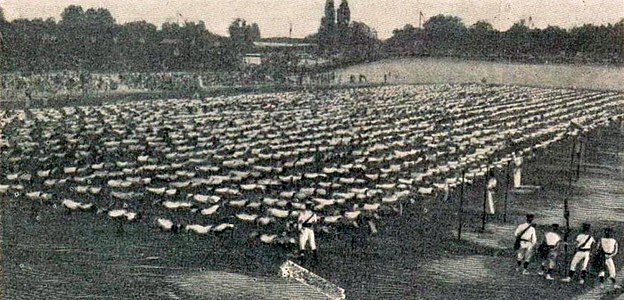
Gymnasts at opening anniversary (Bois de Vincennes)
-

Hélène Pévost, French women's lawn tennis champion at the 1900 Paris Olympics, the first games in which women competed
-
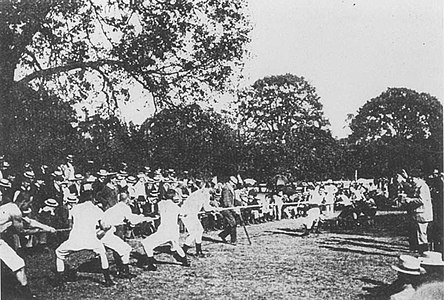
A combined Swedish-Danish team defeated France in the Olympic Tug-of-State of war competition
-

Beginning of the balloon event at the 1900 Summer Olympics (Bois de Vincennes)
Banquet des maires [edit]
Some other special issue at the Exposition was a gigantic banquet hosted by the French President, Émile Loubet, for 20,777 mayors of France, People's democratic republic of algeria and towns in French colonies, hosted on 22 September 1900 in the Tuileries Gardens, inside two enormous tents.[43] The dinner was prepared in eleven kitchens and served to 606 tables, with the orders and needs of each table supervised by telephone and vehicle.[2]
Medals and Awards ceremony [edit]

Michigan Stove Company label
The organizers of the Exposition were not miserly in recognizing the 83,047 exhibitors of products, almost half of whom came from France, and 7,161 from the United States. The awards anniversary was held on 18 August 1900, and was attended by 11,500 persons. 3,156 grand prizes were handed out, 8,889 aureate medals, thirteen,300 silver medals, 12,108 bronze medals, and eight,422 honorable mentions. Many of the participants, such equally Campbell's Soup or Michigan Stove Company, added the Paris laurels to the advertisements and labels of their products.[44]
Admission charges and cost [edit]
The cost of an access ticket was one Franc. At the time, the average hourly wage for Paris workers was between twoscore and 50 centimes. In addition, most popular attractions charged an admission fee, commonly between fifty centimes and Franc. The average toll of a simple repast at the Exposition was 2.fifty Francs, the half-solar day wages of a worker.[45] The corporeality approaching for the Paris Exposition was one hundred million French Francs; xx 1000000 from the French State, xx million from the Urban center of Paris, and the remaining sixty million expected to come from admissions, and backed by French banks and financial institutions.[46]
The official final toll was 119 million Francs, while the total corporeality really collected from access fees was 126 million Francs. However, there were unplanned expenses of 22 million Francs for the French State, and 6 million Francs for the City of Paris, bringing the total price to 147 million Francs, or a deficit of 21 million Francs.[46] The deficit was to a caste offset by the long-term additions to the metropolis infrastructure; new buildings and bridges, including the M and Petit Palais, the Pont Alexander III and the Passerelle Debilly; and additions to the transport organization; The Paris Métro, the funicular railway on Montmartre, and two new train stations, the Gare d'Orsay and the Gare des Invalides, and the new facade and enlargement and redecoration of the Gare de Lyon and other stations.
The Exposition was so expensive to organize and run that the toll per visitor ended up being about 6 hundred francs more than the price of admission. The exhibition lost a grand total of 82,000 francs after six months in operation. Many Parisians had invested money in shares sold to enhance money for the result and therefore lost their investment. With a much larger than expected turnout the showroom sites had gone up in value. Continuing to pay hire for the sites became increasingly hard for concessionaires equally they were receiving fewer customers than predictable. The concessionaires then went on strike, which ultimately resulted in the closure of a large role of the exposition. To resolve the affair, the concessionaires were given a fractional refund of the hire they had paid.[2]
Art Nouveau at the Exposition [edit]
The Fine art Nouveau ("New Art") style began to appear in Belgium and France in the 1880s and became fashionable in Europe and the United states of america during the 1890s.[47] It was highly decorative and took its inspiration from the natural world, particularly from the curving lines of plants and flowers and other vegetal forms. The architecture of the Exposition was largely of the Belle Epoque style and Beaux-Arts style, or of eclectic national styles. Art Nouveau decoration appeared in the interiors and decoration of many of the buildings, notably the interior ironwork and decoration of the Monumental gateway of the Exposition, the Chiliad Palais and the Petit Palais, and in the portal of the Palace of National Industries.
The Art Nouveau style was very popular in the pavilions of decorative arts. The jewelry firm of Fouquet and the glass and crystal manufactory of Lalique all presented collections of Art Nouveau objects.[48] The Sèvres Porcelain Manufactory created a series of monumental swan vases for the Exposition, as well as the monumental archway to the Palace of National Manufacturers.[48]
Many Exposition posters also made utilize of the Art Nouveau way. The piece of work of the well-nigh famous Art Nouveau poster artist, Alfons Mucha, had many forms at the Exposition. He designed the posters for the official Austrian participation in the Exposition, painting murals depicting scenes from the history of Bosnia as well equally the menu for the restaurant at the Bosnian pavilion, and designed the menu for the official opening banquet. He produced displays for the jeweler Georges Fouquet and the perfume maker Houbigant, with statuettes and panels of women depicting the scents of rose, orange bloom, violet and buttercup. His more serious fine art works, including his drawings for Le Pater, were shown in the Austrian pavilion and in the Austrian section of the Grand Palais. Some of his murals can be seen now in the Petit Palais.[49]
The near famous advent was in the edicules, or entrance coverings, of the stations of the Paris Métro designed by Hector Guimard. Nigh were removed not long after the Exposition, but two original edicules remain. It also appeared in the interior decoration of many popular restaurants, notably the Pavillon Bleu at the Exposition, Saying'due south, and the Le Train Bleu eating place of the Gare de Lyon,[50] and in the portal of the Palace of National Manufacturers made past the Sèvres Porcelain Mill. [47]
The Exposition was a showcase not only of French Art Nouveau, but as well the variations that had appeared in other parts of Europe, including the furniture of the Belgian architect and designer Victor Horta, designs of the German Jugendstil by Bruno Möhring, and of the Vienna Secession of Otto Wagner. Their brandish at the Exposition brought the new style international attention.[l]
-

Nymph lamp past Egide Rombaux & François Hoosemans made for the Exposition
-
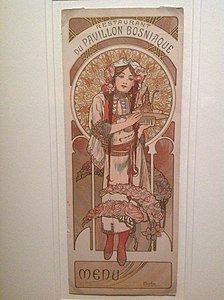
Carte du jour by Alfons Mucha for the eating place of the Bosnia and herzegovina pavilion
-

The Bigot pavilion, showcasing the work of Fine art Nouveau ceramics manufacturer Alexandre Bigot
Legacy [edit]
Most of the palaces and buildings constructed for the Exposition Universelle were demolished after the conclusion of the Exposition and all items and materials that could exist salvaged were sold or recycled. They were built largely of forest and covered with staff, which was formed into columns, statuary, walls, stairs. A few of the major structures built for the Exposition were preserved, including the Grand Palais and the Petit Palais, and the two major bridges, the Pont Alexandre 3 and the Passerelle Debilly, though the latter was afterward dismantled and moved a few dozen meters from its original placement.[51]
Most of the Fine art Nouveau metro station edicules designed past Hector Guimard were removed soon after the Exposition closed, simply two of the originals still exist, including one at its original location, at the Porte Dauphine metro station.
The monumental portal of the Palace of National Manufacturers, made by the Sèvres Manufactory, was preserved and moved to Square Felix-Desruelles, next to the Abbey of Saint-Germain-des-Prés.
A 2.87 metres (9 ft five in) copy of the Statue of Liberty by Frédéric Auguste Bartholdi exhibited at the Fair, was placed in the Luxembourg Gardens in 1905 at the request of his widow.
Afterward visiting the Panorama du Tour du Monde, King Leopold II of Kingdom of belgium commissioned its architect, Alexandre Marcel, to build a Japanese tower and a Chinese pavilion in the Royal Domain of Laeken, Brussels, Belgium. Marcel rebuilt in that location the Japanese cherry pagoda of the Tour du Monde (now known as the Japanese Tower) and moved the original entry pavilion to the tower from Paris. He as well congenital the Chinese Pavilion whose wooden panelling was sculpted in Shanghai. Both structures are now part of the Museums of the Far East.[52]
One of the well-nigh curious vestiges is La Ruche, at two Passage de Dantzig (15th arrond.). This is a 3-story building constructed entirely out of $.25 and pieces of Exposition buildings, purchased at auctions past sculptor Alfred Boucher. The iron roof, made by Gustave Eiffel, originally covered the kiosk of the Wines of Médoc, in the palace of agriculture and foods. The statues of women in theatrical costumes by the forepart door came from the Indochina pavilion, while the ornamental iron gate at the entrance was part of the Palace of Women. In the years subsequently the Exposition, La Ruche served as the temporary studio and home of dozens of young artists and writers including Marc Chagall, Henri Matisse, Amedeo Modigliani, Fernand Léger and the poet Guillaume Apollinaire. It was threatened with demolition in the 1960s but was saved past culture minister André Malraux. It is now a historical monument.[53]
-

Ceramic gateway of Sèvres Porcelain from the Palace of National Manufacturers, now on Square Félx-Desruelles
-

-

La Ruche, an creative person'south colony composed of pieces of unlike Exposition buildings
Criticism [edit]
The Exposition had numerous critics from unlike points of view. The awe-inspiring gateway was described as "defective in taste" and was considered by some critics to be the ugliest of all the exhibits.[7] Calculation to their dislike of La Porte Monumentale Paris was the Parisienne, made by Moreau-Vauthier.[seven] The Parisienne was referred to by some every bit "the triumph of prostitution" considering of her flowing robe and modernized figure and was criticized by many visitors to the triumphal gateway.[2]
The structure of the entrance tower as a whole was adorned with Byzantine motifs and Persian ceramic ornamentation, but the true inspiration behind the piece was non of cultural background.[seven] Binet sought inspiration from science, tucking the vertebrae of a dinosaur, the cells of a beehive, rams, peacocks, and poppies into the design aslope other animalistic stimuli.[7]
La Porte Awe-inspiring Paris is considered to be a structure of the Salammbô manner and 'the most typically 1900 monument of the entire exhibition'.[7] The controversial gateway became known equally La Salamanda amongst the public because it resembled the stocky and intricately designed salamander-stoves of the time, just adding to its ridicule.[ii]
Motion picture footage [edit]
Curt silent actuality films documenting the Exposition by French director Georges Méliès and by Edison Manufacturing Company producer James H. White, have survived.
1900 Paris Exposition footage montage
See also [edit]
- Fine art Nouveau in Paris
- French Colonial Empire
- Paris in the Belle Époque
References [edit]
- ^ Ageorges, Sylvain, Sur les traces des Exposition universelles (2006) pp. 12-15
- ^ a b c d e f yard h i j grand l m northward o p q Allwood, John (1977), The Great Exhibitions, Dandy U.k.: Cassell & Collier Macmillan Publishers, pp. 7–107.[ folio range too broad ]
- ^ Mabire, Jean Christophe (2000) pg. 31
- ^ a b Ageorges (2006) pages 104-105
- ^ a b c Exposition universelle internationale de 1900 à Paris. Rapport général administratif et technique (Study) (in French). Vol. 8. Paris: Ministry of Commerce, Industry, Posts and Telegraphs. French republic. 1902. p. 640. Retrieved 16 November 2021.
- ^ Ageorges, Sylvan. Sur les traces des Expositions Universelles (2004), pg. 238
- ^ a b c d due east f g h i j m l m n o p q Jullian, Philipe (1974), The Triumph of Art Nouveau: Paris Exhibition 1900, New York, New York: Larousse & Co, pp. 38–83.
- ^ Ageorges (2006) pg. 118
- ^ a b Brown, Robert West (2008). "Paris 1900". Encyclopedia of Globe's Fairs and Expositions. McFarland & Company. p. 150.
- ^ Mabire (2000) pg. 89
- ^ a b Mabire (2000), pg. 116
- ^ Ageorges (2006) pg. 110
- ^ Ageorges (2006) pp. 113-114
- ^ Exposition Universelle de 1900 - Catalogue illustré officiel de fifty'exposition décennale des BEAUX-ARTS de 1889 à 1900 (in French). Ludovic Baschet, éditeur. 1900.
- ^ Exposition Universelle de 1900 - Catalogue illustré officiel de l'exposition centennale de l'Art français de 1800 à 1889 (in French). Ludovic Baschet, éditeur. 1900.
- ^ Exposition Universelle de 1900 - Catalogue illustré officiel de l'exposition rétrospective de 50'fine art français des origines à 1800 (in French). Ludovic Baschet, éditeur. 1900.
- ^ Ageorges (2006) pg. 127
- ^ Ageorges (2006) pg. 123
- ^ David Levering Lewis, "A Small Nation of People: W.Due east.B. Du Bois and Blackness Americans at the Plow of the Twentieth Century", A Modest Nation of People: W. E. B. Du Bois and African American Portraits of Progress. New York: Amistad, 2003. 24–49.
- ^ Thomas Calloway, "The Negro Exhibit", in U.S. Commission to the Paris Exposition, Written report of the Commissioner-Full general for the United States to the International Universal Exposition, Paris, 1900, Vol. two (Washington, D.C: Government Press Office, 1901).
- ^ Lasheras Peña, Ana Belén (2 March 2010). España en París. La imagen nacional en las Exposiciones Universales, 1855-1900 (Thesis) (in Spanish). University of Cantabria. pp. 449–474.
- ^ a b c d e Mabire (2000), pp. 62-63
- ^ Ageorges (2006) pp. 116-117
- ^ Gers, Paul. "Paris 1900 - Korea - Strange Nations and Colonies". worldfairs.info.
- ^ "Les points sur les i - Madame Choi". 28 July 2006.
- ^ Vogel, Robert M. (1961). "Lift Systems of the Eiffel Tower, 1889". United States National Museum Message. Washington, D.C.: Smithsonian Institution. 228: twenty–21.
- ^ Mabire (2000) pg. 86
- ^ Mabire (2000) pp. 87-89
- ^ Blaizot, Denis (26 May 1900). "Les trottoirs roulants de l'Exposition". La Revue Scientifique (in French).
- ^ Martin, Henry (1902). Lignes Aeriennes et Trolleys pour Automobile sur Road (Report) (in French). Libraire Polytechnique Ch. p. 29.
- ^ a b Ageorges (2006) pg. 110-111
- ^ Ageorges (2006) pg. 112
- ^ Benjamin, Roger (2005). "Andalusia In The Fourth dimension Of The Moors: Regret and Colonial Presence in Paris, 1900". Edges of Empire: Orientalism and Visual Civilisation. Oxford: Blackwell. pp. 181–205.
- ^ a b c Mabire (2000) pg. 177
- ^ Rousselet, Louis. "Paris 1900 - World Tour Panorama". worldfairs.info.
- ^ Mabire (2000) pg. 80-81
- ^ Skinner 1967, pp. 260–261. sfn error: no target: CITEREFSkinner1967 (help)
- ^ Tierchant 2009, pp. 287–288. sfn error: no target: CITEREFTierchant2009 (help)
- ^ Mallon, Pecker (2009). The 1900 Olympic Games: Results for All Competitors in All Events, with Commentary. McFarland & Company. p. xi. ISBN9780786440641 . Retrieved 15 November 2021.
- ^ "The Olympic Summertime Games Factsheet" (PDF). International Olympic Committee. Archived (PDF) from the original on 6 September 2015. Retrieved 5 August 2012.
- ^ Journal of Olympic History, Special Issue – Dec 2008, The Official Publication of the International Society of Olympic Historians, p. 77, by Karl Lennartz, Tony Bijkerk and Volker Kluge
- ^ "1900 Paris Medal Tally". Archived from the original on April 26, 2019. Retrieved April 26, 2019.
- ^ a b Mabire (2000) pg. 46
- ^ Mabire (1900) pg. 44
- ^ Ageorges (2006), pg. 105
- ^ a b Mabire (2000), pp. 51
- ^ a b Gontar, Cybele. (2006), "Fine art Nouveau", Heilbrunn Timeline of Fine art History. Retrieved from: http://www.metmuseum.org/toah/hd/artn/hd_artn.htm
- ^ a b "ArtfixDaily.com ArtGuild Members". world wide web.artfixdaily.com . Retrieved 2015-eleven-24 .
- ^ Sato 2015, p. 64.
- ^ a b Philippe Jullian, The Triumph of Fine art Nouveau: Paris exhibition, 1900 (London: Phaidon, 1974).
- ^ Ageorges (2006) p. 130
- ^ "History of The Museums of the Far E". Museums of the Far Due east.
- ^ Ageorges (2006) pp. 124-125
Bibliography [edit]
- Ageorges, Sylvain (2006), Sur les traces des Expositions Universelles (in French), Parigramme. ISBN 978-28409-6444-5
- Fahr-Becker, Gabriele (2015). L'Art Nouveau (in French). H.F. Ullmann. ISBN 978-3-8480-0857-v.
- Lahor, Jean (2007) [1901]. Fifty'Art nouveau (in French). Baseline Co. Ltd. ISBN 978-1-85995-667-0.
- Mabire, Jean-Christophe, L'Exposition Universelle de 1900 (in French) (2019), L.Harmattan. ISBN 27384-9309-2
- Sato, Tamako (2015). Alphonse Mucha - the Artist as Visionary. Cologne: Taschen. ISBN978-three-8365-5009-three.
Further reading [edit]
- Alexander C. T. Geppert: Fleeting Cities. Majestic Expositions in Fin-de-Siècle Europe, Basingstoke/New York: Palgrave Macmillan, 2010.
- Richard D. Mandell, Paris 1900: The bang-up earth's off-white (1967)
- Le Panorama : Exposition universelle 1900 (in French). Paris: Ludovic Baschet, éditeur. 1900. Retrieved half-dozen December 2021.
- Liste des récompenses : Exposition universelle de 1900, à Paris (Report) (in French). Paris: Ministry of Commerce, Industry, Posts and Telegraphs. French Commonwealth. 1901. Retrieved 6 December 2021.
External links [edit]
- 1900 Paris at the BIE
- Exposition Universelle 1900 in Paris. Photographs at Fifty'Art Nouveau
- Universal and International Exhibition of Paris 1900 at worldfairs.info
- Inventing Entertainment: The Early Motion Pictures and Sound Recordings of the Edison Companies: "exposition universelle internationale de 1900 paris, france" (search results). A set of films past Edison from the Expo 1900
- 1900 Palace of Electricity. Thomas A. Edison. Archived from the original on 2021-11-17. Retrieved 2009-05-xx .
1900-08-09
1 minute film pan shot from Gnaw de Mars - 1900 Panoramic view of the Place de l'Concord. Thomas A. Edison. Archived from the original on 2021-xi-17. Retrieved 2009-05-20 .
1900-08-29
1 infinitesimal 39 seconds moving picture pan shot from Place de la Concorde - 1900 Esplanade des Invalides. Thomas A. Edison. Archived from the original on 2021-11-17. Retrieved 2009-05-20 .
1900-08-09
2 minute flick pan shot from Esplanade des Invalides and 10 seconds of Chateau d'Eau from Tour Eiffel - "Unrecognizable Paris: The Monuments that Vanished", an article at Messy Nessy Cabinet of Chic Curiosities
- The Burton Holmes lectures; v.two. Round about Paris. Paris exposition at Cyberspace Archive
Coordinates: 48°51′22″N two°17′52″East / 48.8561°Northward two.2978°E / 48.8561; 2.2978
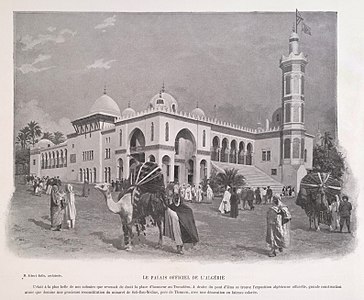

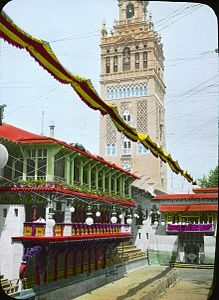
0 Response to "Fashion of the 1900 Party Champagne Color Ne"
Post a Comment